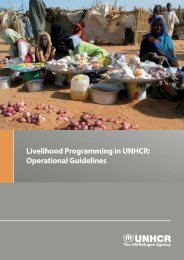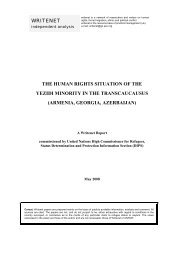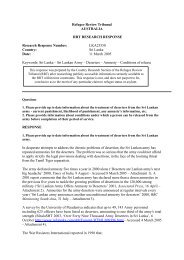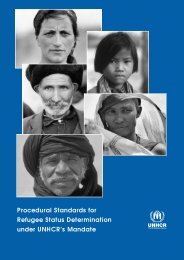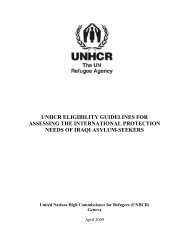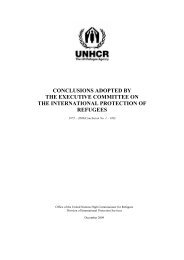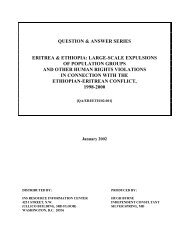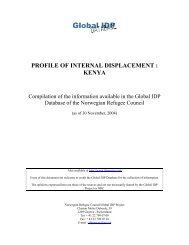UNHCR's ELIGIBILITY GUIDELINES FOR ASSESSING THE ...
UNHCR's ELIGIBILITY GUIDELINES FOR ASSESSING THE ...
UNHCR's ELIGIBILITY GUIDELINES FOR ASSESSING THE ...
You also want an ePaper? Increase the reach of your titles
YUMPU automatically turns print PDFs into web optimized ePapers that Google loves.
IV. PARTICULAR GROUPS AT RISK<br />
A. Religious Groups<br />
1. Muslims<br />
a) Shi’ites and Sunnis Civilians<br />
i) Historical Background of the Sectarian Division in Iraq<br />
The religious division of the Muslim community into Sunni and Shi’ite sects traces back to<br />
the 7 th century, when Muslim scholars disputed the question of who was rightfully qualified<br />
to lead the Muslim community after the Prophet Mohammed’s death. This dispute resulted<br />
in the most important schism in Islam. The Shi’ites believed that leadership should stay<br />
within the family of the Prophet, and thus designated Ali ibn Abi Talib, Mohammed’s sonin-law<br />
and cousin, as his successor (caliph). Sunni Muslims, however, believed that the<br />
caliph should be chosen based on a community consensus and elected Abdullah ibn<br />
Uthman (also known as Abu Bakr) as the first caliph. He was followed by Omar and<br />
Othman, while Ali ibn Abi Talib became only the fourth caliph. The Shi’a do not recognize<br />
Abu Bakr, Omar and Othman as the first three caliphs and instead consider Ali as the first<br />
caliph, which the Shi’ites call Imam. Ali moved the Islamic capital from Medina in presentday<br />
Saudi-Arabia to Kufa in Iraq. He was buried in Najaf, which is, therefore, of great<br />
religious significance for the Shi’ites.<br />
The division over the question of succession led to a violent power struggle and split the<br />
community of Muslims into two branches. Both observe the same fundamental tenets of<br />
Islam, but have different approaches to religious law and practice. A major difference is the<br />
significance of the Imam. For the Shi’ites, the Imams have a spiritual significance which no<br />
Sunni cleric would be given. The 12 th Shi’ite Imam disappeared in the 10 th century and the<br />
majority of Shi’ites (Twelver Shi’a) believes that he will return at the end of time. He is<br />
known as the Hidden Imam or the Mehdi. 146<br />
Generally, Sunni Muslims constitute the vast majority in most Muslim countries (an<br />
estimated 85%), but the Muslim population in Iraq is divided into a 60 to 65% majority of<br />
Shi’ites and a 32 to 37% minority of Sunni Muslims, the latter including ethnic Arabs,<br />
Kurds and Turkmen. 147 Arabs of Sunni faith constitute between 15% and 20% of the total<br />
Iraqi population. 148 Shi’ites in Iraq are almost exclusively ethnic Arabs, with some Kurds<br />
and Turkmen. Iraq’s Sunni Arabs are concentrated in the valleys of the Euphrates River<br />
north of Baghdad and of the Tigris River between Baghdad and Mosul in the so-called<br />
146<br />
Matthew S. Gordon, Islam: Origins – Practices – Holy Texts – Sacred Persons – Sacred Places, New<br />
York 2002, p. 16; Hussein Abdulwaheed Amin, The Origins of the Sunni/Shia split in Islam,<br />
http://www.islamfortoday.com/shia.htm; Mike Shuster, The Origins of the Shia-Sunni Split, NPR,<br />
12 February 2007, http://www.npr.org/templates/story/story.php?storyId=7332087.<br />
147<br />
CIA, The World Factbook, Iraq, https://www.cia.gov/library/publications/the-world-factbook/geos/<br />
iz.html [last updated 8 February 2007].<br />
148<br />
CFR, Iraq: The Sunnis, 12 December 2003, http://www.cfr.org/publication/7678/.<br />
47





